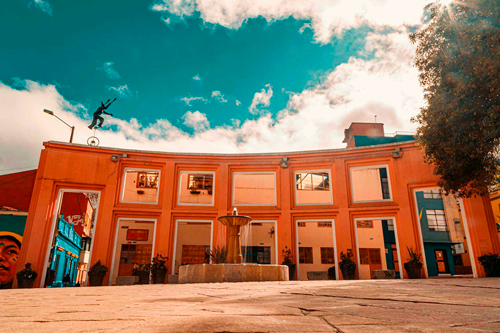
El Mirador Restaurant - Hotel de La Opera
It works on the top floor of the Hotel de la Opera in the La Candelaria neighborhood, giving it a gorgeous and captivating view. It is a very cozy place where you can enjoy live music on Friday and Saturday nights, accompanied by exquisite international and Mediterranean dishes. The view towards the main domes of the Historic Center is truly unique.
La Scala Restaurant - Hotel de La Opera
La Scala restaurant is located in a gorgeous republican building inside the Hotel de la Opera. It delights, charms, and captivates all visitors. It has two environments, one in the central courtyard and a more formal one in the adjacent lounge. The food quality is excellent; the service is personalized, warm, and agile. The menu offers Mediterranean-style dishes as well as Colombian dishes.
Building memories of LGBTI people
Come to the launch event of an exciting photo exhibition that tells the story of LGBTI people in Bogotá! This exhibition not only celebrates diversity but also brings an innovative strategy to strengthen memory processes around the city's organizations.
How to get there?
Dignas Biografías
Celebrate the diversity of people in Bogotá with our permanent photographic exhibition, a special highlight during Pride Month.
Join us for the launch of the exhibition "Dignas Biografías: lo personal hace memoria marikona y colectiva." At this event, you can enjoy the results of two creative workshops. During these workshops, several photographs from the Museum of Bogotá collections were artistically intervened to give visibility to LGBTIQ+ bodies and the locations where they have historically taken part in collective resistance movements.
Mi cuerpo dice la verdad
Live an incredible experience from Cúcuta here in Bogotá: A tour through the Truth Commission exhibition followed by the striking play Mi cuerpo dice la verdad (My body tells the truth) presented by the group Arte-Sana y Movimiento Visibles de Cúcuta!
Explore the stories that reveal the truth and resilience, fusing art and testimony to create a powerful impact. An unmissable opportunity to connect the history and culture of the movement present in Bogotá but originating in Cúcuta!
Queer and Subversive Arts Festival
For six exciting days, you will enjoy a diverse program of dance workshops, stunning performances, art screenings, a local brand fair, and live music.
Our main goal is to create a friendly and safe environment where diverse communities can connect, share experiences, and discover new forms of expression in inclusive spaces.
How to get there?
ElectroLab: Laboratory for the creation of instruments for electronic music
On these vacations, enjoy learning how to create your own amplifier, theremin, and synthesizer to dive into sound experimentation and compose your own songs.
Real chocolate Tasting
In this experience, you will learn to differentiate real chocolate from a substitute.
By tasting real cocoa-based chocolate, you will experience a variety of flavors and aromas activating your five senses.
In this tasting, you will explore the different percentages of cocoa and discover how they influence the flavor, aroma, and texture of the final chocolate.
Duration:
- 20 - 30 min
Includes:
Tasting the Colombian cacoa: workshops, experiences, stores and more
It is a workshop focused on sharing the gastronomic flavors of the central region of Colombia. The participants will have the experience of learning how to prepare the typical santafereño chocolate.
Duration: 1 hour
Includes:
- Apron and cap.
- Ingredients for preparation.
What will you learn?